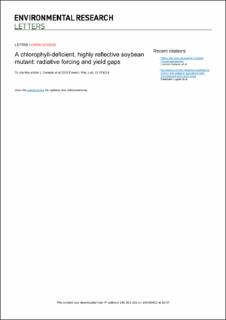| dc.contributor.author | Genesio, L. | |
| dc.contributor.author | Bright, Ryan M. | |
| dc.contributor.author | Alberti, G. | |
| dc.contributor.author | Peressotti, A. | |
| dc.contributor.author | Vedove, G. Delle | |
| dc.contributor.author | Incerti, G. | |
| dc.contributor.author | Toscano, P. | |
| dc.contributor.author | Rinaldi, M. | |
| dc.contributor.author | Muller, O. | |
| dc.contributor.author | Miglietta, F. | |
| dc.date.accessioned | 2021-03-11T11:43:13Z | |
| dc.date.available | 2021-03-11T11:43:13Z | |
| dc.date.created | 2021-03-01T11:29:01Z | |
| dc.date.issued | 2020-06-22 | |
| dc.identifier.citation | Environmental Research Letters. 2020, 15 (7), . | en_US |
| dc.identifier.issn | 1748-9326 | |
| dc.identifier.uri | https://hdl.handle.net/11250/2732865 | |
| dc.description.abstract | Sunlight absorbed at the Earth’s surface is re-emitted as longwave radiation. Increasing atmospheric concentrations of CO2 and other greenhouse gases trap an increasing fraction of such heat, leading to global climate change. Here we show that when a chlorophyll (Chl)-deficient soybean mutant is grown in the field, the fraction of solar-irradiance which is reflected, rather than absorbed, is consistently higher than in commercial varieties. But, while the effect on radiative forcing during the crop cycle at the scale of the individual experimental plot was found to be large (−4.1± 0.6 W m−2 ), global substitution of the current varieties with this genotype would cause a small increase in global surface albedo, resulting in a global shortwave radiative forcing of −0.003 W m−2 , corresponding to 4.4 Gt CO2eq. At present, this offsetting effect would come at the expense of reductions to yields, probably associated with different dynamic of photosynthetic response in the Chl-deficient mutant. The idea of reducing surface-driven radiative forcing by means of Chl-deficient crops therefore requires that novel high-yielding and high-albedo crops are made available soon. | en_US |
| dc.language.iso | eng | en_US |
| dc.publisher | IOP Publishing | en_US |
| dc.rights | Navngivelse 4.0 Internasjonal | * |
| dc.rights.uri | http://creativecommons.org/licenses/by/4.0/deed.no | * |
| dc.title | A chlorophyll-deficient, highly reflective soybean mutant: radiative forcing and yield gaps | en_US |
| dc.type | Peer reviewed | en_US |
| dc.type | Journal article | en_US |
| dc.description.version | publishedVersion | en_US |
| dc.rights.holder | © 2020 The Author(s) | en_US |
| dc.source.pagenumber | 14 | en_US |
| dc.source.volume | 15 | en_US |
| dc.source.journal | Environmental Research Letters | en_US |
| dc.source.issue | 7 | en_US |
| dc.identifier.doi | 10.1088/1748-9326/ab865e | |
| dc.identifier.cristin | 1894466 | |
| dc.relation.project | Norges forskningsråd: 254966 | en_US |
| dc.source.articlenumber | 074014 | en_US |
| cristin.ispublished | true | |
| cristin.fulltext | original | |
| cristin.qualitycode | 2 | |

